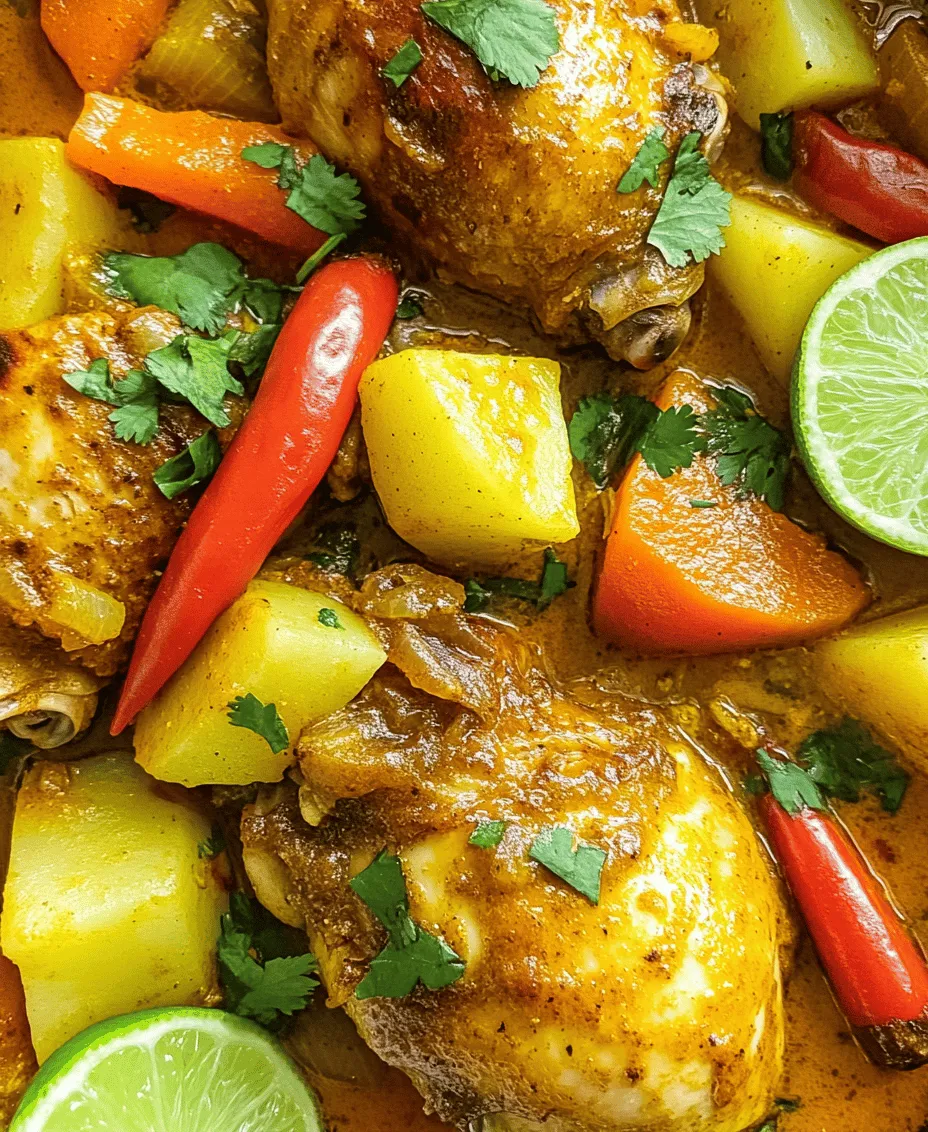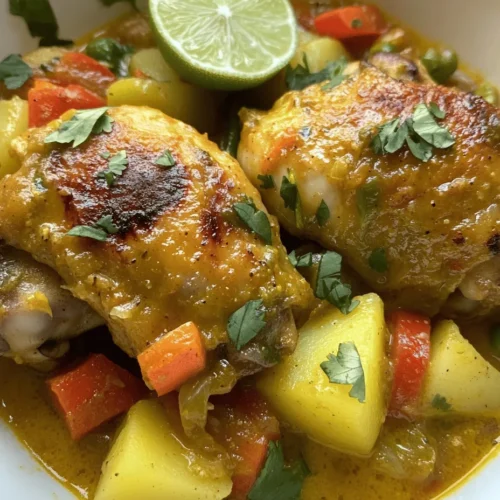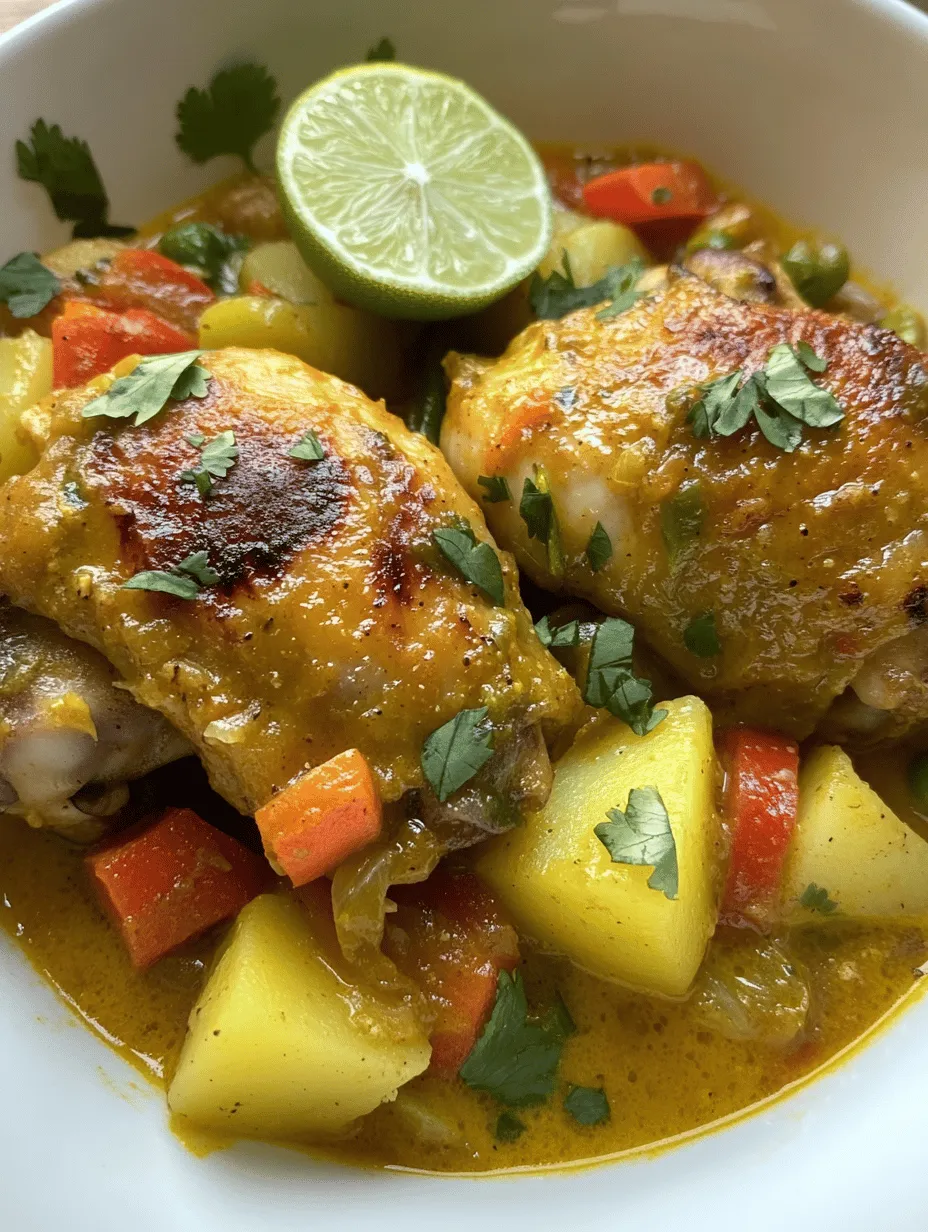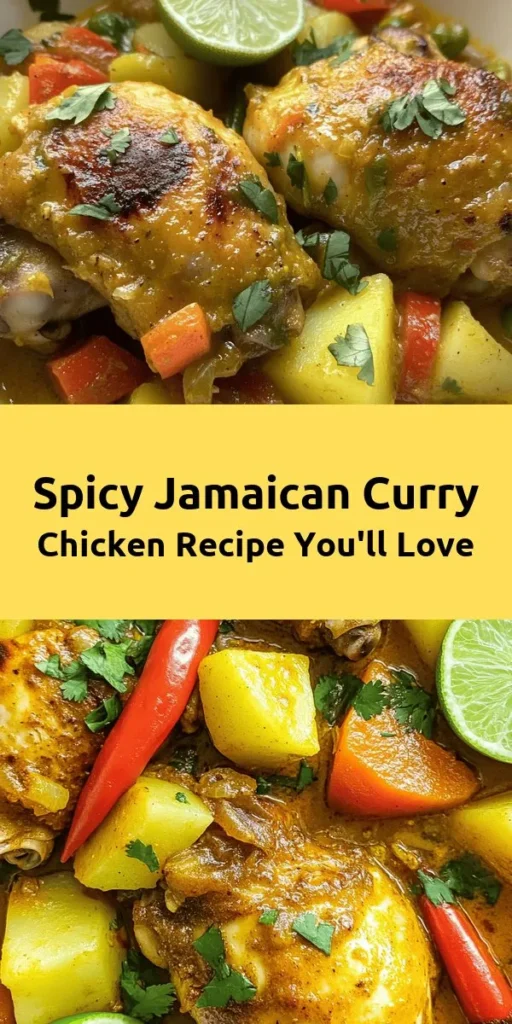Introduction
Jamaican cuisine is a vibrant tapestry woven from the rich cultural heritage of the island, celebrating a fusion of flavors, spices, and cooking techniques that reflect the diverse influences of its history. From the spicy jerk chicken to the sweet and savory festival dumplings, the culinary landscape of Jamaica showcases a love for bold flavors and fresh ingredients. Among the many delectable dishes that define this cuisine, Jamaican curry chicken stands as a beloved staple, celebrated for its aromatic spices and robust taste.
Curry chicken is more than just a dish; it embodies the spirit of the Caribbean, where cooking is often a communal activity, bringing families and friends together around the dining table. The history of curry in Jamaica is an intriguing blend of indigenous practices and international influences, particularly from Indian cuisine, which has played a significant role in shaping the island’s culinary identity. When prepared authentically, Jamaican curry chicken captures the essence of the island with its unique flavor profile, making it a must-try for anyone seeking a taste of the Caribbean.
To achieve the traditional flavors of authentic Jamaican curry chicken, it is essential to focus on the use of genuine ingredients and preparation methods. This article will guide you through the process of creating this mouthwatering dish, detailing the necessary ingredients, cooking techniques, and flavor profiles that make this recipe shine. From the use of Jamaican curry powder to the heat of Scotch bonnet peppers, each element contributes to the dish’s authentic taste, ensuring that every bite transports you to the sun-drenched shores of Jamaica.
Understanding Jamaican Curry Chicken
To fully appreciate Jamaican curry chicken, it’s essential to delve into the historical context of curry within Jamaican cuisine and the influences that have shaped this beloved dish. The introduction of curry to Jamaica can be traced back to the 19th century when Indian indentured laborers arrived on the island. They brought with them their culinary traditions, including the use of spices like turmeric, coriander, and cumin, which would eventually blend with local ingredients and cooking styles.
As the years went by, the Jamaican adaptation of curry evolved, resulting in a dish that is distinctly different from its Indian counterparts. Jamaican curry chicken is characterized by its vibrant yellow color, thanks to the turmeric in the curry powder, and its use of fresh herbs and spices that give it a unique Caribbean twist. The dish is often simmered in coconut milk, which adds a creamy richness, while the heat from Scotch bonnet peppers elevates the flavor profile, making it a true representation of the island’s culinary creativity.
The key ingredients that define authentic Jamaican curry chicken play a significant role in achieving its signature taste. At the heart of the dish is Jamaican curry powder, a blend of spices that differs from the standard curry powders found elsewhere. This unique blend often includes ingredients such as allspice, fenugreek, and ginger, which contribute to its distinct flavor and aroma. When selecting curry powder for this recipe, it is crucial to choose a high-quality Jamaican brand to ensure the most authentic experience.
Another essential component of Jamaican curry chicken is the Scotch bonnet pepper, which adds heat and complexity to the dish. Known for its fruity flavor and intense spiciness, the Scotch bonnet is a staple in Caribbean cooking. The heat level can vary depending on the variety of the pepper, so adjusting the quantity used in the recipe allows you to customize the spice level to your preference.
Fresh herbs such as thyme and cilantro are also integral to achieving the authentic flavors of Jamaican curry chicken. Thyme, in particular, is a common herb used in Caribbean cooking, imparting an earthy aroma that complements the spices beautifully. Meanwhile, cilantro adds a refreshing note to the dish, balancing the richness of the coconut milk and the heat of the peppers.
Ingredients Breakdown
To create authentic Jamaican curry chicken, it’s essential to gather the right ingredients that will enhance the dish’s traditional flavors. Each component plays a vital role, contributing to the overall taste and texture. Here’s a detailed breakdown of the key ingredients you’ll need for this flavorful recipe:
Chicken Thighs
When it comes to the protein for your curry chicken, chicken thighs are the preferred choice. Opting for bone-in and skin-on thighs not only adds depth of flavor but also ensures that the meat remains juicy and tender throughout the cooking process. The bones contribute to a rich broth, while the skin helps to keep the meat moist as it cooks. For an authentic experience, ensure that the chicken is cut into pieces, allowing the spices to penetrate the meat thoroughly.
Jamaican Curry Powder
The heart of this dish lies in the Jamaican curry powder, which is distinct in its flavor profile compared to other curry powders. A quality Jamaican curry powder typically contains a blend of spices, including turmeric, coriander, cumin, and allspice. This combination creates a warm, aromatic flavor that is essential for authentic Jamaican curry chicken. When selecting curry powder, look for brands that emphasize their Jamaican roots, as this will provide you with the most authentic taste.
Scotch Bonnet Peppers
No discussion of Jamaican curry chicken would be complete without mentioning the Scotch bonnet pepper. Known for its fiery heat and unique fruity flavor, this pepper is a hallmark of Caribbean cuisine. The heat level of Scotch bonnets can vary, so it’s important to taste and adjust according to your spice tolerance. For those who prefer a milder dish, consider using less of the pepper or removing the seeds, which contain much of the heat.
Coconut Milk
Coconut milk is another key ingredient in authentic Jamaican curry chicken, contributing both flavor and texture. This creamy liquid adds richness to the dish, balancing the spices and heat from the Scotch bonnet peppers. It also helps to create a luscious sauce that coats the chicken and vegetables. When selecting coconut milk, look for brands that contain minimal additives for the best flavor.
Vegetables
In addition to chicken, Jamaican curry chicken often includes an array of colorful vegetables that enhance the dish’s nutritional value and add layers of flavor. Common choices include bell peppers, onions, carrots, and potatoes. Each vegetable not only contributes to the overall taste but also provides essential nutrients, making the dish well-rounded and satisfying.
Preparation Steps for Authentic Flavor
Now that you have a clear understanding of the ingredients that define authentic Jamaican curry chicken, it’s time to delve into the preparation steps that will elevate your cooking experience. Preparing this dish involves a few essential steps that ensure the flavors meld beautifully and create a harmonious curry that embodies the essence of Jamaican cuisine.
1. Marinate the Chicken: Begin by marinating the chicken thighs with Jamaican curry powder, salt, and freshly chopped herbs, such as thyme and cilantro. This step allows the chicken to absorb the flavors and ensures that every bite is bursting with the essence of the spices.
2. Sauté the Aromatics: In a large pot or Dutch oven, heat a splash of oil over medium heat. Add diced onions, garlic, and ginger, sautéing until the onions become translucent and fragrant. This step is crucial, as it builds the foundational flavors of the curry.
3. Add the Chicken: Once the aromatics are ready, add the marinated chicken to the pot. Sear the chicken pieces on all sides until they are golden brown. This not only adds color but also enhances the flavor through the Maillard reaction, ensuring that your curry has a rich taste.
4. Incorporate the Vegetables: After the chicken is browned, add in your choice of vegetables, such as bell peppers and carrots. Stir to combine, allowing them to cook for a few minutes until they begin to soften.
5. Pour in the Coconut Milk: Next, add the coconut milk to the pot, stirring to combine all the ingredients. The richness of the coconut milk will create a luscious sauce that envelops the chicken and vegetables.
6. Spice it Up: Finally, add the Scotch bonnet pepper, either whole or chopped, depending on your spice preference. Allow the curry to simmer gently, letting the flavors meld together and the chicken cook through.
7. Taste and Adjust: As the curry simmers, taste the sauce and adjust the seasoning as needed, adding more salt, curry powder, or herbs to achieve the desired flavor profile.
With these preparation steps, you’re well on your way to creating an authentic Jamaican curry chicken that captures the spirit of the Caribbean. The combination of aromatic spices, fresh ingredients, and traditional cooking techniques will ensure that your dish is not just a meal but a flavorful journey to the heart of Jamaica. Stay tuned for the next part of the article, where we’ll explore additional cooking tips, variations, and serving suggestions to make your Jamaican curry chicken experience even more enjoyable.

Marination Process
Marination is an essential step in making authentic Jamaican curry chicken. Allowing the chicken to marinate not only enhances its flavor but also tenderizes the meat, making it more succulent and delicious. The spices used in the marinade penetrate the chicken, ensuring that every bite is packed with flavor.
Importance of Letting the Chicken Absorb Flavors
Marinating serves multiple purposes: it infuses the chicken with the rich, aromatic spices characteristic of Jamaican cuisine while also breaking down proteins, which can lead to a more tender texture. The longer you allow the chicken to marinate, the more robust the flavor will be. This is especially important when using strong spices such as curry powder, allspice, and thyme.
Recommended Marination Time for Optimal Results
For optimal results, marinate your chicken for at least 2 hours. However, if time allows, aim for 6 to 8 hours, or even overnight. This extended marination period allows the spices to meld beautifully into the meat, resulting in a more flavorful dish. If you’re short on time, even a 30-minute marinade can improve the flavor, but it may not reach the depth that longer marination provides.
Sautéing Aromatics
Once your chicken has marinated to perfection, it’s time to sauté the aromatics. This step is crucial as it lays the flavorful foundation for your curry.
Techniques for Enhancing Flavor
To enhance the flavor of your sautéed aromatics, start by heating oil in a large pot or Dutch oven over medium heat. Once the oil is shimmering, add in your diced onions and sauté them until they become translucent. This process releases their natural sweetness, which will be a wonderful contrast to the spices in the dish.
Tips on Achieving the Perfect Onion and Garlic Sauté
When sautéing onions, be patient. Avoid the temptation to turn up the heat to speed up the process. A slower cook allows the sugars in the onion to caramelize, providing a sweeter flavor. After the onions have softened, add minced garlic and sauté for an additional 30 seconds to 1 minute. Garlic can burn quickly, which leads to bitterness, so keep an eye on it.
Browning the Chicken
Browning the marinated chicken is a pivotal step that not only enhances the dish’s flavor but also adds a beautiful color.
The Science Behind Caramelization
Caramelization occurs when the sugars in the chicken and spices react to heat, creating a rich, complex flavor and a deep color. It’s essential to brown the chicken in batches to avoid overcrowding the pan, which can lead to steaming rather than browning.
Importance of Browning for Depth of Flavor
Browning the chicken also creates fond—the brown bits stuck to the bottom of the pan—which will add depth of flavor to your dish once deglazed. After browning, remove the chicken and set it aside while you build the sauce.
Building the Dish
Now that your chicken is marinated and browned, it’s time to bring all the elements together into the pot.
Infusing Heat and Flavor with Scotch Bonnet Peppers and Thyme
Add chopped Scotch bonnet peppers to the pot, adjusting the quantity according to your preferred spice level. These peppers are a staple in Jamaican cooking, providing a unique heat and fruity flavor. Along with fresh thyme, they will deepen the aromatic profile of your curry.
Techniques for Adjusting Spiciness
If you prefer a milder curry, you can remove the seeds from the Scotch bonnet peppers before chopping them. Alternatively, use fewer peppers or substitute with a milder variety, such as jalapeño. Remember, you can always add more heat later, but it’s challenging to tone it down once it’s in the pot.
The Simmering Phase
After adding your aromatics and spices, return the browned chicken to the pot along with any remaining marinade. Pour in your coconut milk and chicken broth, which will create a rich sauce. Bring the mixture to a gentle simmer. This is the stage where the magic happens—allowing the chicken to become tender and the flavors to meld.
Understanding the Role of Coconut Milk and Chicken Broth
Coconut milk not only adds creaminess but also balances the heat from the Scotch bonnet peppers, creating a harmonious flavor profile. The chicken broth provides additional depth and richness to the sauce. Together, they create a luscious base for your curry.
Adding Vegetables: Timing and Method for Best Results
In the final simmer, add your choice of vegetables—carrots, bell peppers, and potatoes are excellent options. Add them at this stage to ensure they cook through without becoming mushy. The key is to add sturdier vegetables first, allowing them to soften before adding quicker-cooking ingredients.
Suggestions for Alternative Vegetables
Feel free to experiment with seasonal vegetables or personal favorites. Zucchini, green beans, or even eggplant can add an interesting texture and flavor to the dish. Just be mindful of cooking times to maintain the integrity of each vegetable.
Final Touches and Serving Suggestions
Once your curry chicken is simmered to perfection, it’s time for the final touches.
Importance of Tasting and Adjusting Flavors Before Serving
Before serving, always taste your curry. This is your opportunity to adjust the seasoning or balance the heat. If it’s too spicy, a splash of coconut milk can help mellow the flavors. If it needs more depth, consider adding a pinch of salt or a dash of soy sauce.
Tips on Balancing Heat and Seasoning
To balance heat, consider serving lime wedges on the side. The acidity from the lime will help cut through the richness of the curry and provide a refreshing contrast.
Garnishing with Fresh Cilantro
To enhance both the visual appeal and the flavor of your dish, garnish with freshly chopped cilantro just before serving. This herb adds a bright freshness that complements the deep flavors of the curry.
Serving Options: Traditional Accompaniments
Authentic Jamaican curry chicken is typically served with steamed rice or rice and peas. The rice absorbs the delicious sauce, creating a well-rounded meal. You can also serve it with fried plantains or a simple green salad for added texture and flavor.
Suggestions for Side Dishes
For a complete Jamaican feast, consider pairing your curry with sides like festival (sweet fried dumplings), coleslaw, or steamed vegetables. These sides can provide a delightful contrast to the rich and spicy curry.
Conclusion
Creating authentic Jamaican curry chicken is a flavorful journey that combines marinated chicken, aromatic spices, and wholesome ingredients. Each step, from the marination process to the final garnishing, contributes to a dish that is not only delicious but also culturally significant.
Sharing meals is a cherished tradition in Jamaica, where food brings people together. The communal aspect of enjoying curry chicken reflects the island’s vibrant culture and hospitality. As you embark on your culinary adventures, let this recipe inspire you to explore and embrace various cooking traditions in your home kitchen. The flavors of Jamaica await you, promising an unforgettable dining experience. Enjoy every bite!



